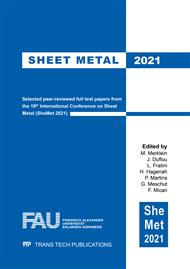p.242
p.250
p.258
p.269
p.277
p.285
p.294
p.303
p.309
Fracture Characterisation by Butterfly-Tests and Damage Modelling of Advanced High Strength Steels
Abstract:
Advanced High Strength Steels (AHSS) are widely used in today's automotive structures for lightweight design purposes. FE simulation is commonly used for the design of forming processes in automotive industry. Therefore, besides the description of the plastic flow behaviour, also the definition of forming limits in order to efficiently exploit the forming potential of a material is required. AHSS are prone for crack appearances without prior indication by thinning, like exemplary shear fracture on tight radii and edge-fracture, which can not be predicted by conventional Forming Limit Curve (FLC). Stress based damage models are able to do this. However, the parameterisation of such models has not yet been standardised. In this study a butterfly specimen geometry, which was developed at the Institute for Forming Technology and Machines (IFUM), was used for a stress state dependent fracture characterisation. The fracture behaviour of two AHSS, CP800 and DP1000, at varied stress states between pure shear and uniaxial loading was characterised by an experimental-numerical approach. For variation of the stress state, the specimen orientation relative to the force direction of the uniaxial testing machine was orientated at different angles. In this way, the relevant displacement until fracture initiation was determined experimentally. Subsequently, the experimental tests have been numerically reproduced giving information about the strain and stress evolution in the crack impact area of the specimen for the experimentally identified fracture initiation. With the help of this testing procedure, two different stress-based damage models, Modified Mohr-Coulomb (MMC) and CrachFEM, were parameterised and compared.
Info:
Periodical:
Pages:
294-302
Citation:
Online since:
April 2021
Authors:
Keywords:
Price:
Сopyright:
© 2021 Trans Tech Publications Ltd. All Rights Reserved
Share:
Citation:


